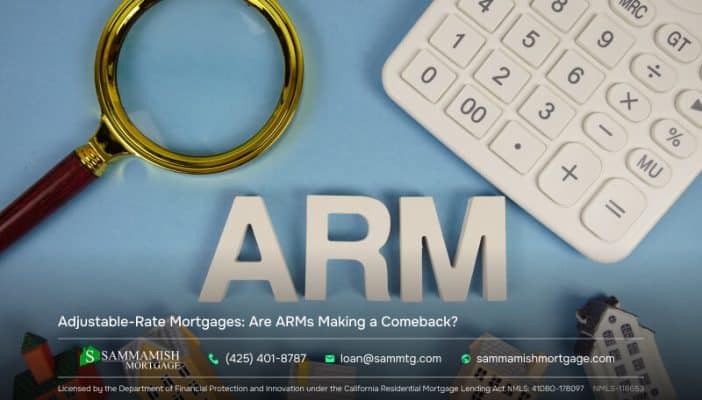No Obligation and transparency 24/7. Instantly compare live rates and costs from our network of lenders across the country. Real-time accurate rates and closing costs for a variety of loan programs custom to your specific situation.

Amidst elevated interest rates and shifting economic conditions, home buyers are re-evaluating their mortgage options. One mortgage product that’s regaining momentum is the adjustable-rate mortgage (ARM) — a loan type that may be considered risky but now offers potential savings and flexibility. So, are ARMs making a comeback in the U.S.? The data says yes, and the reasons are worth exploring. This guide will dive into trends surrounding ARMs, the benefits they may offer, and the types of borrowers who might benefit most.
An adjustable-rate mortgage (ARM) is a home loan where the interest rate fluctuates over time. Unlike fixed-rate mortgages, ARMs adjust periodically based on the lender’s prime rate, which closely follows the policy rate.
ARMs feature two phases:
Yes, ARMs have increased in popularity over recent months. Despite the recent slowdown in demand for mortgages, adjustable-rate mortgages gained traction during the week ending September 12, 2025, accounting for 12.9% of all mortgage applications, according to the Mortgage Bankers Association (MBA). In fact, the share of ARMs climbed to its highest level since 2008, signaling renewed interest in adjustable-rate options amid shifting market conditions.
While ARMs carry some risk due to fluctuating rates, they can offer significant savings for buyers navigating a high interest rate environment. Built-in rate caps also help protect borrowers from sharp increases, making ARMs a more manageable option.
Eventually, the economic landscape will stabilize, but in the meantime, ARMs may provide the flexibility buyers need to move forward with a home purchase.
Several factors may be driving the resurgence of ARMs:
With fixed mortgage rates having remained elevated since early 2022, many home buyers are turning to ARMs for their lower introductory rates. Even a slight difference can translate into hundreds of dollars in monthly savings.
Home prices remain high in many U.S. markets, and buyers are looking for ways to stretch their budgets. ARMs offer lower initial payments, allowing borrowers to qualify for larger loan amounts or reduce monthly costs.
The Federal Reserve is widely expected to begin cutting interest rates in late 2025. Borrowers who choose ARMs now may benefit from lower rates in the future, especially once their adjustable period begins.
| Adjustable-Rate Mortgage (ARM) | Fixed-Rate Mortgage | |
| Initial Interest Rate | Lower | Higher |
| Rate Stability | Variable after fixed period | Constant |
| Monthly Payment Changes | Possible after intro term | Fixed |
| Long-Term Predictability | Less predictable | Highly predictable |
| Best For | Short-term plans, flexibility | Long-term stability |
Be sure to weigh the perks and drawbacks of ARMs before applying.
If you’re considering an adjustable-rate mortgage, here are some tips to help you make a smart decision:
Know how long your fixed-rate period lasts, how often the rate adjusts, and what caps are in place.
Can you handle a higher payment if rates rise? Build a buffer into your budget to prepare for potential increases.
Use online tools to compare ARM products to make sure you’re making the most financially sound decision. Look at the APR, not just the initial rate.
If you expect to move, refinance, or pay off your mortgage early, an ARM could save you money upfront.
ARMs aren’t for everyone, but they can be a smart choice for certain borrowers.
| For example, a young professional buying a starter home may benefit from a 5/1 ARM, knowing they’ll likely upgrade or relocate within five years. |
| For example, a first-time home buyer on a tight budget who plans to stay put for 10+ years may find a fixed-rate mortgage more suitable than an ARM. |
How does an ARM differ from a fixed-rate mortgage?
A fixed-rate mortgage keeps the same interest rate for the entire loan term, while an ARM has a variable rate that can increase or decrease after the initial fixed period.
What causes the interest rate to change?
ARM rates are tied to a financial index (like SOFR or Treasury rates) plus a margin set by the lender. When the index changes, your rate adjusts accordingly.
What are rate caps in an ARM?
Rate caps limit how much your interest rate can increase.
Are ARMs risky?
They can be if interest rates rise sharply. However, modern ARMs include protections like rate caps and stricter underwriting standards to reduce risk.
Who should consider an ARM?
ARMs are ideal for borrowers who plan to sell or refinance before the adjustable period begins, or those who expect interest rates to decline.
Can I refinance an ARM into a fixed-rate mortgage?
Yes, many borrowers refinance into a fixed-rate loan before the ARM begins adjusting, especially if rates are expected to rise.
Can my monthly payment go down with an ARM?
Yes, if the index rate drops, your interest rate and monthly payment may decrease — though this depends on your loan’s terms and caps.
Are ARMs available for investment properties or second homes?
Yes, ARMs can be used for primary residences, second homes, and investment properties, though rates and terms may vary.
What should I look for in an ARM loan offer?
Pay close attention to the initial rate, adjustment schedule, index, margin, rate caps, and whether there are any fees or penalties. These details affect your long-term costs and risk exposure.
Adjustable-rate mortgages seem to be making a comeback in the U.S. housing market. With fixed rates still high and affordability stretched thin, ARMs offer an attractive alternative for home buyers who value flexibility and short-term savings. However, they’re not a one-size-fits-all solution. But for the right borrower, ARMs can unlock opportunities that fixed-rate mortgages may not offer.
Are you ready to buy a home and want to use an adjustable-rate mortgage to finance it? If so, Sammamish Mortgage can help. We are a local mortgage company from Bellevue, Washington serving the entire state, as well as Oregon, Idaho, Colorado, and California. We offer many mortgage programs, including ARMs, to buyers all over the Pacific Northwest and have been doing so since 1992. Contact us today with any questions you have about mortgages, or visit our website to get an instant rate quote.


Whether you’re buying a home or ready to refinance, our professionals can help.
{hours_open} - {hours_closed} Pacific
No Obligation and transparency 24/7. Instantly compare live rates and costs from our network of lenders across the country. Real-time accurate rates and closing costs for a variety of loan programs custom to your specific situation.
Adjust the parameters based on what you want to track